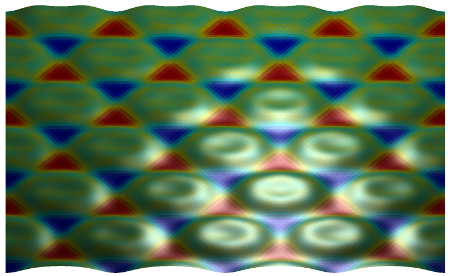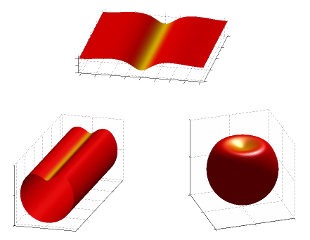Research Interests
Elastic materials are objects which deform under the application of a force, but are able to recover their original shape when that force is removed. Elastic objects that are thin in one direction — including flat two-dimensional plates (like paper) and shells (their curved counterparts) — provide a rich array of interesting problems, with applicability in materials science, biology, industry and other settings. I work closely on such systems in collaboration with co-workers in the Waves in Complex Continua research group.
One of my main interests has been in problems where deformation in plates and shells is linked to internal fields in the material. The canonical example is thermoelasticity, where elastic bodies expand in response to high temperature, which couples with elastic deformation. This can be seen most clearly in a bimetallic strip, where differences in expansion coefficients in the two components of the strip cause it to bend in response to high temperature. Similarly, plates can deform in response to electric fields (piezoelectricity). Other internal fields in elastic plate models include pseudo-magnetic fields in graphene, and growth fields in biological tissues (see below).
Graphene
Over the last few years graphene has become a subject of intense interest and research. Since Andre Geim and Konstantin Novoselov won the Nobel Prize in Physics in 2010 for their groundbreaking experiments, graphene research has continued its inexorable rise, with new theoretical insights and experimental work setting the stage for many exciting applications.1
Graphene is a two-dimensional hexagonal lattice of carbon atoms. This combination of strong covalent bonds and a nanometer-scale thickness means that it is exceptionally strong for its size, while being remarkably flexible in response to bending deformations. Allied to this mechanical strength are its electronic properties.2,3 In crystals like graphene, the electrons behave as though they had no mass (relativistically), with a velocity of around 106 m/s. This characteristic behaviour, together with a number of other unique properties, mean that graphene is being studied as a basis for a new generation of nanoscale electronic components.

Since graphene's hexagonal lattice gives rise to its electron transport properties, it follows that modifying this lattice by straining the graphene sheet can alter these properties. Under the influence of the strain field, the electrons behave as though they were subject to a magnetic field — though no such field is present.4,5 In certain circumstances this so-called pseudo-magnetic field can reach values of hundreds of Tesla.6
This naturally leads to the question of how one might strain a graphene sheet in order to generate a certain desired pseudo-magnetic field. For in-plane deformations, this is quite straightforward due to the linearity of the equations: the solution is a stretched configuration with three-fold symmetry.7 However, this approach won't work if out-of-plane deformations are included, since the strain field is now a nonlinear function of displacement. Computational methods are necessary here, and with co-workers at the National University of Singapore I have developed a numerical optimization technique which will allow one to determine the deformation necessary for a graphene flake to exhibit a desired pseudo-magnetic field.8
Mechanics in Biology
Continuum mechanics, especially elastic and viscous models, have been widely used to describe and model the deformation of biological structures.9 Perhaps the key factor to account for when modeling biological materials is their ability to change over time. The three basic processes that tissues exhibit are changes in size, material properties, and shape (growth, remodeling, and morphogenesis).10 Mechanical models that include these effects have a wide range of applications, from cardiovascular mechanics and cancer growth to embryonic development and bone densification.11
My main interests are in growth and morphogenesis, since these two processes regulate the final shape of an organism. Including these factors in a continuum mechanical model introduces new terms ('active terms') into the governing equations. Volumetric growth in an elastic model, for instance, is modeled in a similar way to thermal expansion, and in linear elasticity the temperature- (or growth-) dependent term appears as a body force in the governing Navier equations. On the other hand in viscous models of pollen tube growth, growth is modeled by a source term in the mass conservation equation.12

My focus lies broadly in two areas. First, I am interested in developing continuum models of growth and developmental processes where the active terms are derived from the underlying micromechanical process. For instance, in embryonic development, apical constriction is a mechanism causing bending of epithelial tissues through the contraction of fibers embedded near the cells' surface. By modeling this contraction explicitly in an elastic shell model, I showed that the effect was kinematically equivalent to a traction imposed on the shell surface. The examples (right) show the effect in flat, cylindrical, and spherical geometries,13 with a lighter color indicating greater contraction.
Secondly, I am interested in combining these derived models with observational morphometric data on the growth and developmental process in tissues, to answer basic questions about the mechanics of this process. This brings to mind D'Arcy Thompson's famous grid deformations, and in particular his desire to uncover the physical mechanism behind the variation in shape.14 In a continuum mechanical model, biological control occurs through the active terms, and so a physically-based morphometric technique should be based around optimizing these terms. In this vein I have developed a quasiconformal morphometric technique that embodies these principles, within a framework readily extensible to similar mapping functions.15
References
- 1 H. Brody (ed.) (2012). Nature Outlook: Graphene. Nature, 483(7389):S29–S44.
- 2 A.H. Castro Neto, F. Guinea and N.M.R. Peres (2006). Drawing conclusions from graphene. Physics World, 19(11):33–37.
- 3 A.H. Castro Neto (2012). Selected topics in graphene physics. Lecture Notes in Physics, 843:117–144.
- 4 V.M. Pereira and A.H. Castro Neto (2009). Strain engineering of graphene's electronic structure. Physical Review Letters, 103(4):046801.
- 5 F. Guinea (2012). Strain engineering in graphene. Solid State Communications, 152(15):1437–1441.
- 6 N. Levy, S.A. Burke, K.L. Meaker, M. Panlasigui, A. Zettl, F. Guinea, A.H. Castro Neto and M.F. Crommie (2010). Strain-induced pseudo-magnetic fields greater than 300 Tesla in graphene nanobubbles. Science, 329(5991):544–547.
- 7 F. Guinea, M.I. Katsnelson and A.K. Geim (2009). Energy gaps and a zero-field quantum Hall effect in graphene by strain engineering. Nature Physics, 6(1):30–33.
- 8 G.W. Jones and V.M. Pereira (2014). Designing electronic properties of two-dimensional crystals through optimization of deformations. New Journal of Physics, 16(9):093044.
- 9 Y.C. Fung (1993). Biomechanics: Mechanical Properties of Living Tissues. Springer, 2nd ed.
- 10 L.A. Taber (1995). Biomechanics of growth, remodeling, and morphogenesis. Applied Mechanics Reviews, 48(8):487–545.
- 11 G.W. Jones and S.J. Chapman (2012). Modeling growth in biological materials. SIAM Review, 54(1):52–118.
- 12 O. Campàs and L. Mahadevan (2009). Shape and dynamics of tip-growing cells. Current Biology, 19(24):2102–2107.
- 13 G.W. Jones and S.J. Chapman (2010). Modelling apical constriction in epithelia using elastic shell theory. Biomechanics and Modeling in Mechanobiology, 9(3):247–261.
- 14 D.W. Thompson (1945). On the theory of transformations, or the comparison of related forms. On Growth and Form. Cambridge University Press.
- 15 G.W. Jones and L. Mahadevan (2013). Planar morphometry, shear and optimal quasi-conformal mappings. Proceedings of the Royal Society A, 469(2153):20120653.